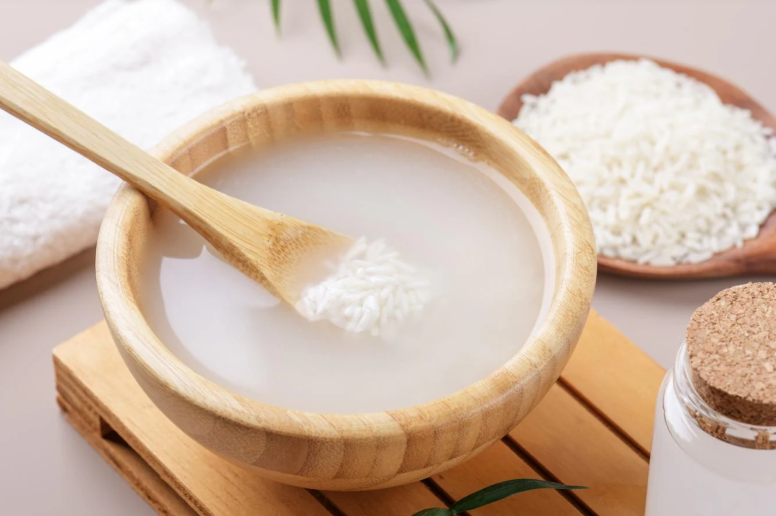The increasing consumer awareness of the ecological impact of their beauty choices is driving the cosmetics industry towards sustainable, natural, and eco-friendly alternatives. Rice, particularly in Asia, is valued for its nutritional, medicinal, and skincare properties. Rice contains amino acids, peptides, organic acids, polyphenols, vitamins, and polysaccharides, which provide diverse skincare benefits. Recent trends show increased scientific interest in rice for skincare applications. Fermentation has emerged as an innovative process that enhances the bioactive potential of rice, yielding more effective skincare ingredients. This review analyzes the biologically active components in rice fermentation products (RFPs) and their skincare benefits. It addresses the fermentation process and advantages of RFPs, analyzes their key bioactive components and skincare benefits, discusses challenges related to formulation and standardization, and outlines potential future research directions.
Key Points:
•Rice Fermentation and Its Advantages: The review details the rice fermentation process, which involves selecting raw rice, inoculating it with specific microbial strains, controlling fermentation conditions, and extracting and purifying bioactive components. Microorganisms like Lactobacillus, Saccharomyces cerevisiae, and Aspergillus species are commonly used. The fermentation process enhances the biocompatibility and bioavailability of rice while reducing irritation, thereby improving its efficacy in topical skincare applications.
•Increased Production of Bioactive Compounds: Fermentation significantly enhances the production of bioactive compounds in rice, such as phenolic and peptide content, resulting in enhanced antioxidant and anti-inflammatory activities.
•Enhanced Biocompatibility and Bioavailability: Fermentation breaks down high-molecular-weight compounds into smaller substances, improving their biocompatibility and bioavailability, making them more effective for the skin.
•Improved Skin Tolerance and Reduced Irritation: Fermented rice ingredients are milder on the skin compared to non-fermented ones, which is beneficial for sensitive skin. The fermentation process helps break down allergenic proteins and potential irritants, reducing the risk of skin irritation or allergic reactions.
•Sustainability and Environmental Benefits: Fermentation is more sustainable, requiring fewer resources and generating less waste compared to traditional extraction methods.
•Bioactive Components in RFPs: RFPs contain amino acids, peptides, organic acids, polyphenols, polysaccharides, vitamins, and minerals. Amino acids maintain skin hydration, while peptides improve skin hydration and stimulate collagen production. Organic acids provide exfoliation, moisturization, and skin barrier repair. Polyphenols protect the skin from oxidative stress. Polysaccharides attract and retain moisture. Vitamins and minerals support normal skin physiological functions.
•Skincare Benefits of RFPs: RFPs offer enhanced skin hydration, improved barrier function, antioxidant protection, skin whitening, anti-inflammatory effects, and anti-aging properties. They elevate levels of hyaluronic acid and enhance the expression of hyaluronan synthase, which are vital for maintaining skin hydration. RFPs can enhance the integrity and function of the skin barrier. They are rich in antioxidants, which effectively neutralize free radicals and protect the skin from oxidative damage. RFPs can significantly reduce cellular melanin content and decrease tyrosinase activity, leading to a whitening effect. They also exhibit anti-inflammatory properties, reducing the levels of inflammation-related factors. RFPs containing photoprotective compounds offer ultraviolet protection properties. They promote collagen synthesis and inhibit collagen degradation, leading to anti-aging effects. RFPs help balance the skin microbiome by increasing beneficial microorganisms and reducing harmful pathogens.
•Challenges and Limitations of RFPs: The review highlights the challenges in the widespread application of RFPs, including the standardization and consistency of RFPs due to variability in fermentation processes. There is a lack of comprehensive understanding regarding the components and inter-related mechanisms of RFPs. Existing research is predominantly limited to in vitro studies and animal models, with a notable lack of clinical trials involving human subjects. The sensory attributes of RFPs, including irritation potential and odor, require further optimization for skincare applications.
This research highlights that microbial fermentation enhances the value of rice by increasing the production of bioactive compounds, improving their bioavailability, and reducing skin irritation. RFPs show promise as cosmetic ingredients due to their diverse bioactive compounds, offering moisturizing, skin barrier repair, antioxidant, anti-inflammatory, brightening, and anti-aging effects. Future research should focus on optimizing production standardization, refining component analysis, elucidating mechanisms of action, and conducting large-scale clinical trials to support efficacy and safety. The integration of bioinformatics with advanced 3D skin models offers insights into how RFPs interact with the skin, enabling the targeting of bioactive compounds to address specific skin concerns. RFPs, especially those containing probiotics, can support the skin’s microbiome by promoting beneficial microorganisms and inhibiting harmful ones.
Link to the study: https://www.mdpi.com/2079-9284/12/1/29

